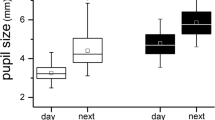Abstract
Using 12 healthy volunteers, we tested the parasympatholytic effects on the eye. In a randomized crossover double-blind trial, hyoscine-N-butylbromide was tested against saline. Before (20 or 40 mg IV) and up to 45 min after the injection, pupillar light reaction, accommodation, visual acuity, and nyctometer values were measured. The range of accommodation diminishes according to dosage: 9–15 min after the injection, the inhibition is maximum; 45 min after the injection, only a small effect remains, even using the 40 mg dosage. Pupillary reaction is little affected by either dosage, and the pupil diameters at the end of the reaction are only slightly greater after the injection of either dosage than after placebo injection. The time constant of the reaction remains unchanged. Visual acuity and nyctometer values remain unchanged under the influence of hyoscine-N-butylbromide. The results are discussed with respect to the potential ability of a patient to meet the requirements of modern traffic. According to our findings, there are no opthalmologically-based reasons for an emmetropic person to assume impaired driving abilities after a single injection of hyoscine-N-butylbromide of up to 40 mg. If the accommodative capacity of a patient is impaired whose hyperopia is not fully corrected, the ability to drive in modern traffic may be impaired. After a single dose of 20 mg hyoscine-N-butylbromide (i.e., 1 ampule Buscopan), the impairment of even these patients does not last longer than about 45 min.
Similar content being viewed by others
References
Aulhorn E, Ehrke F (1969) Neue Untersuchungen über die Nachtmyopie. Ber Dtsch Ophthalmol Ges 70: 284–290
Bleichert A, Wagner R (1956) Versuche zur Erfassung des Pupillenspiels als Regelungsvorgang. Z Biol 109: 70–80
Campbell FW, Gregory AH (1960) Effect of size of pupil on visual acuity. Nature 187: 1121–1123
Krause R, Krause-Liebscher I (1961) Zur Erklärung des Phänomens der Nachtmyopie. Klin Monatsbl Augenheilkd 139: 338–344
Morgan SS, Hollenhorst RW, Ogle KN (1968) Speed of pupillary light response following topical pilocarpine or tropicamide. Am J Ophthalmol 66: 835–844
Schober H (1948) Die Nachtmyopie und ihre Ursachen. Graefe's Arch Clin Exp Ophthalmol 148: 171–186
Wald G, Griffin DR (1947) The change in refractive power of the human eye in dim and bright light. J Opt Soc Am 37: 321–336
Woodhouse JM (1974) The effect of pupil size on grating detection at various contrast levels. Vision Res 15: 645–648
Author information
Authors and Affiliations
Rights and permissions
About this article
Cite this article
Mehlfeld, G., Bleichert, A. The effect of anticholinergic drugs on the inner eye muscles. Graefe's Arch Clin Exp Ophthalmol 224, 92–95 (1986). https://doi.org/10.1007/BF02144145
Received:
Accepted:
Issue Date:
DOI: https://doi.org/10.1007/BF02144145




